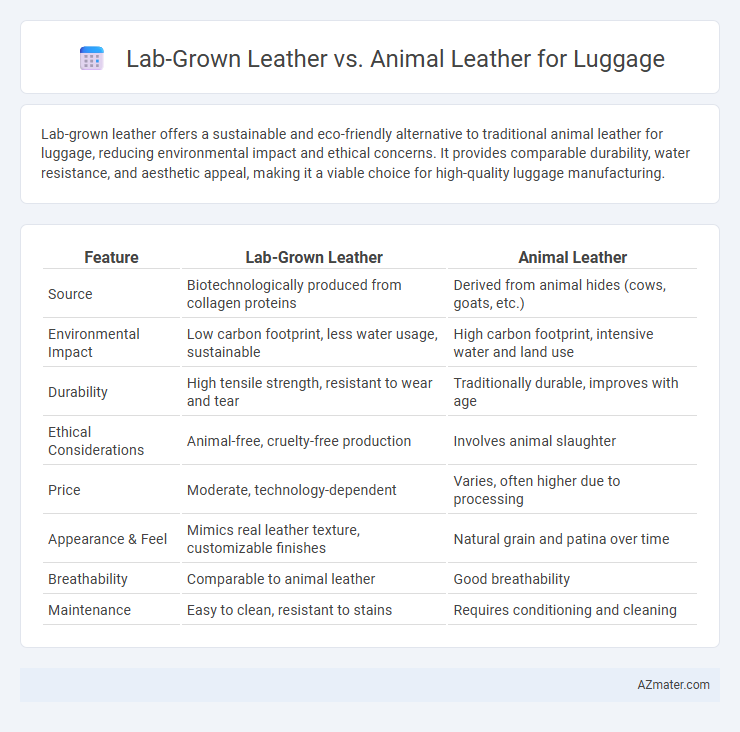Lab-grown leather offers a sustainable and eco-friendly alternative to traditional animal leather for luggage, reducing environmental impact and ethical concerns. It provides comparable durability, water resistance, and aesthetic appeal, making it a viable choice for high-quality luggage manufacturing.
Table of Comparison
| Feature | Lab-Grown Leather | Animal Leather |
|---|---|---|
| Source | Biotechnologically produced from collagen proteins | Derived from animal hides (cows, goats, etc.) |
| Environmental Impact | Low carbon footprint, less water usage, sustainable | High carbon footprint, intensive water and land use |
| Durability | High tensile strength, resistant to wear and tear | Traditionally durable, improves with age |
| Ethical Considerations | Animal-free, cruelty-free production | Involves animal slaughter |
| Price | Moderate, technology-dependent | Varies, often higher due to processing |
| Appearance & Feel | Mimics real leather texture, customizable finishes | Natural grain and patina over time |
| Breathability | Comparable to animal leather | Good breathability |
| Maintenance | Easy to clean, resistant to stains | Requires conditioning and cleaning |
Introduction to Lab-Grown vs Animal Leather
Lab-grown leather, crafted through biofabrication using collagen proteins, offers a sustainable alternative to traditional animal leather derived from cowhide and other animal skins. This innovative material mimics the texture, durability, and breathability of animal leather while significantly reducing environmental impact, such as lowering greenhouse gas emissions and water usage. Its potential for customization and cruelty-free production makes lab-grown leather an emerging choice for eco-conscious luggage designs.
Production Processes Compared
Lab-grown leather for luggage is produced through biofabrication techniques, where collagen fibers are cultured from animal cells in controlled environments, reducing resource consumption and waste compared to traditional leather tanning. Animal leather production involves raising livestock, followed by chemical-intensive processes such as tanning, dyeing, and finishing, which contribute significantly to environmental pollution and high water usage. The lab-grown leather process offers a more sustainable and efficient alternative by minimizing harmful emissions and accelerating production timelines without compromising durability or aesthetic qualities.
Environmental Impact and Sustainability
Lab-grown leather used for luggage significantly reduces environmental impact by minimizing deforestation, water consumption, and greenhouse gas emissions compared to traditional animal leather. Animal leather production contributes heavily to methane emissions, extensive land use, and chemical pollution from tanning processes, which threaten biodiversity and water quality. Sustainable alternatives like lab-grown leather promote circular economy principles by using renewable resources and reducing waste throughout the manufacturing lifecycle.
Durability and Longevity in Luggage
Lab-grown leather offers enhanced resistance to wear and tear due to its controlled manufacturing process, making it highly durable for luggage. Animal leather, prized for its natural strength and ability to develop a unique patina over time, provides exceptional longevity when properly maintained. Both materials excel in durability, but lab-grown leather's consistency ensures fewer imperfections, while animal leather benefits from proven resilience in heavy-use travel conditions.
Aesthetic and Design Flexibility
Lab-grown leather offers enhanced aesthetic versatility and design flexibility compared to traditional animal leather, enabling precise control over texture, color, and pattern for luggage applications. Its uniformity and consistency allow designers to experiment with innovative finishes and customized embossing that are often challenging with animal leather's natural variations. This adaptability supports the creation of unique, stylish, and sustainable luggage pieces tailored to diverse consumer preferences.
Cost Analysis: Lab-Grown vs Animal Leather
Lab-grown leather for luggage offers a cost advantage by reducing expenses tied to animal rearing, slaughtering, and traditional leather tanning, leading to lower production costs. While initial lab-grown leather prices can be higher due to technology investments, economies of scale are rapidly decreasing costs, making it increasingly competitive with animal leather. In contrast, animal leather remains expensive due to supply chain complexities and environmental compliance costs, positioning lab-grown leather as a more economical and sustainable option for premium luggage manufacturers.
Ethical Considerations in Leather Choices
Lab-grown leather offers a cruelty-free alternative to traditional animal leather, eliminating the need for animal slaughter and reducing animal welfare concerns. The production of lab-grown leather significantly lowers environmental impacts such as deforestation and greenhouse gas emissions associated with livestock farming. Choosing lab-grown leather for luggage aligns with ethical consumerism by promoting sustainable practices and minimizing harm to animals and ecosystems.
Performance Under Travel Conditions
Lab-grown leather offers enhanced durability and water resistance compared to traditional animal leather, making it ideal for luggage exposed to varied travel conditions. Its uniform texture resists abrasions and maintains shape better under frequent handling and temperature changes. Animal leather, while offering natural breathability and patina development, is more susceptible to scratches and requires regular maintenance to sustain performance during extensive travel.
Consumer Preferences and Market Trends
Lab-grown leather offers sustainable and cruelty-free alternatives favored by eco-conscious consumers seeking high-quality luggage materials, driving its market growth. Animal leather remains popular for its traditional durability, luxury appeal, and aging characteristics, sustaining its demand among premium buyers. Market trends show increasing investment in lab-grown leather technology, reflecting a shift towards environmentally friendly products without compromising style and functionality in luggage.
The Future of Luggage: Which Leather Leads?
Lab-grown leather offers a sustainable alternative to animal leather, significantly reducing environmental impact by eliminating the need for livestock farming and decreasing greenhouse gas emissions. Technological advancements in bio-fabrication and material science are enhancing the durability and aesthetic appeal of lab-grown leather, making it increasingly suitable for high-quality luggage production. As consumer demand shifts towards ethical and eco-friendly products, lab-grown leather is poised to lead the future of luggage by combining innovation with sustainability.

Infographic: Lab-grown leather vs Animal leather for Luggage
 azmater.com
azmater.com